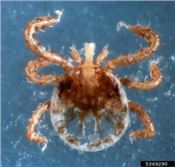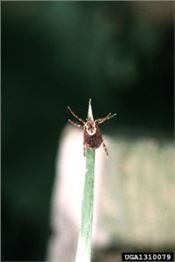As Autumn Approaches, Don’t Forget About Ticks
DR. JONATHAN L. LARSON
PRINCETON, KENTUCKY
While the high tick season in Kentucky is usually May and June, there are still ticks this late in the summer. Ticks are arachnids; they are related to other eight-legged critters like spiders and mites. Ticks progress through multiple life stages starting as an egg, from which a larva will hatch, the larva will progress to be a nymph, which finally matures to be an adult. Interestingly, despite being arachnids, they start life with only six legs as a larva.
Adult Lonestar and American dog ticks are still active right now.
It’s also important to note that Lonestar tick larvae are also out and about right now. These tiny ticks are sometimes called seed ticks or turkey mites because of their size; people can end up with dozens of them on their legs if they unfortunately come across them in the wild. According to tick surveys done through the Department of Entomology, this is the most common species of tick that lives in Kentucky, so the odds of encountering them are higher than the other species. Kentucky is also heading towards adult season for black legged deer ticks, which are well known for their ability to transmit the pathogen that causes Lyme disease.
Where Are You Likely To Encounter Ticks?
Ticks prefer overgrown habitat. They try to avoid UV light and will inhabit the edges of habitats, like a field edge or the border of a forest. The three main species of concern don’t just feed on humans; they can also be found in nature where other hosts like mice, deer, and birds live. When people go hunting and fishing, hiking, work outdoors, or stroll through parks, they are often entering tick territory.
When ticks need a blood meal, they will go to the ends of blades of grass or the tips of shrub branches and “quest,” a behavior where they stick their front arms out and wait for a potential host to walk by. Once they find a victim, they will crawl up the body and find an area with thinner skin and plenty of blood vessels to feed.
How Can You Protest Yourself?
Due to the possibility of acquiring a tickborne illness, it is highly recommended that people take precautions when going into areas with probable tick populations. When going out for a simple evening stroll or light gardening in the backyard, it is still a good idea to apply an insect repellent. DEET, IR3535. Picaridin, and oil of lemon eucalyptus are all options that have data to support their use against mosquitoes and ticks. When purchasing products, keep in mind that the percentages listed on the label are important. For quick excursions outdoors (like the walk and gardening mentioned before) products with 25 percent to 40 percent of the active ingredient listed would be sufficient. For hiking, hunting, fishing, or other long-term activities, consider using products in the 75 percent to 100 percent range. These repellents are all labelled for application to skin and clothing.
Campers and others may also want to consider using permethrin on their clothing. This is an insecticide that should not be applied to bare skin. Permethrin can be self-applied to clothing items or some camping stores carry permethrin impregnated clothes. When ticks come into contact with the permethrin residue, they will die. This means that when taking off the clothing, there could be dozens of dead ticks that fall out. Use caution with permethrin around cats as it is toxic to them.
Finally, remember to take care of pets that go outdoors. Flea and tick medication from a veterinarian keeps pets safe from tick bites and possible pathogens as well. Dogs can acquire Lyme disease as well, so give them protection! Pets that are treated are also less likely to accidentally bring a tick into their home, a situation that can lead to bites happening indoors when it is least expected. ∆
DR. JONATHAN L. LARSON: Entomology Extension specialist, University of Kentucky

Figure 1: This Lonestar tick nymph is only about the size of a poppy seed; they are often called seed ticks.
When people find them on their body, they may have to remove a high number of them.
Photo: Susan Ellis, USDA APHIS PPQ, Bugwood.org

Figure 2: This American dog tick is questing for a potential host. Ticks are usually at ankle or knee level in the landscape.
Photo: Jim Occi, BugPics, Bugwood.org